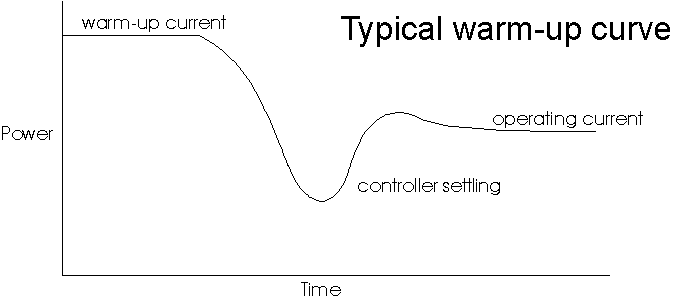The power consumed by an ovenized oscillator is primarily determined by the quality of the insulation, the size of the internal oven and the ambient temperature. Oven oscillator power consumption is frequently specified during warm-up and after stabilization at room temperature. The steady-state power requirements may be projected from knowledge of the oscillator’s thermal conductance. If an oscillator has a thermal conductance of 10 mw per degree, the power consumption will increase by 50 mw for an ambient temperature drop of 5 degrees. The temperature at which the oven will “lose control” may be projected from the room temperature power consumption since the oven controller cannot drop the current below the amount needed to operate the circuitry. Typically, foam insulated oscillators require 20mw per degree centigrade and will consume between 1 and 2 watts at room temperature. Dewar insulated oscillators can require less than 10mw per degree and consume below 1 watt at room temperature. The room temperature consumption depends on the operating temperature of the oven as the watts per degree concept would suggest. Increasing the oven setpoint from 80 to 90 degrees causes a typical foam insulated oscillator to consume about 200 milliwatts more power. The oven setpoint must be above the highest ambient temperature specified plus the temperature rise due to the fixed power consumption (oven oscillators do not have air-conditioning).

Warm-up time depends on the warm-up power, starting temperature and oven mass. It takes more joules to heat a thick copper oven structure than a thin aluminum structure and the required joules will enter the oven faster if the turn-on power is higher. The warm-up current should be significantly higher than the current required to keep the oven warm at the coolest ambient temperature or the warm-up time may be unacceptably long at the cold temperature extreme. After the oven reaches the desired operating temperature the oscillator will continue to drift as the crystal and circuitry reach thermal equilibrium. SC-cut crystals are superior to AT-cut crystals during warm-up because thermal gradients across the crystal have far less effect on the frequency. Smaller, faster oven oscillators are appealing but the more massive ovens will exhibit better short-term stability (all other factors being equal) so avoid specifying short warm-up times with little warm-up power whenever practical. Certain new oscillator designs employ superior insulation techniques including evacuated housings and Dewar flasks. Dewar flasks are a superior choice since the evacuated space is free from out-gassing components and the removable flask makes manufacture and repair vastly easier. Smaller ovens will consume less power and precision ovens are shrinking to a size barely larger than the crystal thanks to surface-mount components and hybrid techniques. SC-cut crystals are more immune to thermal transients and are the favorite in the smaller oven designs. Wenzel associates has developed a 1.3 inch cube Dewar insulated oscillator with specifications rivaling much larger designs. The WAMO (Wenzel Associates Miniature Oscillator) is available in commercial and fully space qualified versions and was designed as a lower cost alternative to more exotic designs.